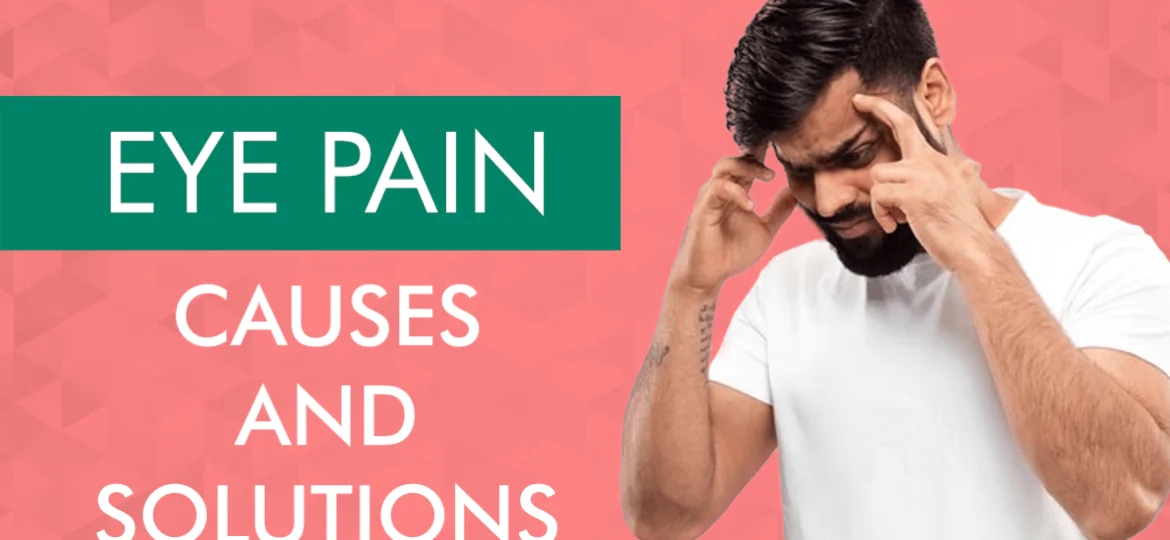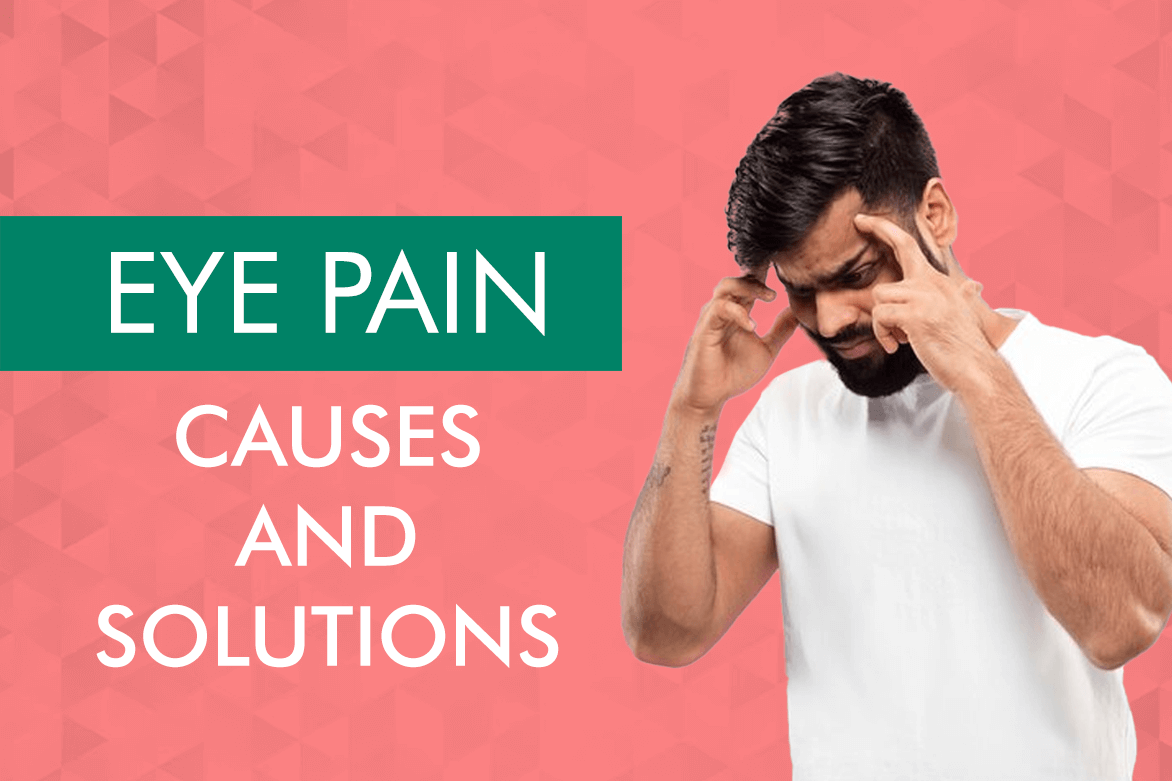
Eye Pain Causes and Solutions

Our eyes are like our personal cameras capturing the world around us. But what happens when they start hurting or paining? Well, it is a pretty common issue and can happen for different eye pain reasons. It might be because we spend too much time looking at screens or due to other issues.
In this blog, we’ll talk about why our eyes might hurt, what are eye pain reasons, and what are eye pain treatments. From simple tricks to relax our eyes to when it’s time to see a doctor, let’s explore the eye pain causes and eye pain solutions in an easy understandable manner.
What Is Eye Pain?
Eye pain refers to any discomfort or pain experienced in or around the eyes. Major eye pain reasons could be sharp or dull ache, burning sensation, or throbbing pain. Eye pain can be accompanied by other symptoms like redness, itching, tearing, sensitivity to light, blurred vision, or headache. It is important to identify the underlying eye pain reasons to determine the appropriate treatment.
Common Causes of Eye Pain
Below are the common reasons for eye pain:
- Eye Strain: Prolonged use of digital devices, reading in poor lighting conditions, or focusing on a specific task for an extended period can be one of significant eye pain reasons that strain the eyes and cause discomfort. It is essential to practice good eye habits, such as taking regular breaks, adjusting screen brightness, and using proper lighting to reduce eye ache and prevent discomfort.
- Dry Eyes: Insufficient tear production or poor tear quality can lead to dryness and irritation in the eyes, causing pain. To alleviate dry eyes, consider using artificial tears or a humidifier to add moisture to the air, staying hydrated, and incorporating omega-3 fatty acids into your diet.
Also Read about Eye Infections from Contacts
- Conjunctivitis (Pink Eye): This contagious infection causes inflammation of the conjunctiva, the thin tissue covering the white part of the eye and inner surface of the eyelids. It can result in eye redness, itching, and discomfort. Proper hygiene, such as washing hands frequently, avoiding touching the eyes, and using separate towels and pillowcases, can help prevent the spread of pink eye.
- Corneal Abrasions: Scratches or injuries to the cornea, the clear front surface of the eye, are also among eye pain reasons, causing redness, and sensitivity to light. It is crucial to protect the eyes from potential injuries by wearing safety glasses during activities that pose a risk of eye injuries.
- Sinusitis: Inflammation or infection of the sinuses can lead to eye ache, causing discomfort. Managing sinusitis with nasal decongestants, saline nasal sprays, and steam inhalation can help alleviate pressure and reduce eye pain associated with sinus issues.
- Migraines or Headaches: Certain types of migraines or headaches can cause eye pain as a symptom. Managing migraines with stress-reducing techniques, proper hydration, and regular sleep patterns can help reduce the frequency and intensity of headaches and associated eye pain.
- Glaucoma: Increased pressure within the eye can damage the optic nerve and cause eye pain, along with other symptoms like blurred vision and halos around lights. Regular eye exams and early detection of glaucoma are essential for preventing vision loss and managing eye pain associated with this condition.
- Iritis: Inflammation of the iris, the colored part of the eye, can cause eye pain, sensitivity to light, and blurred vision. Treatment for this may include prescription eye drops, corticosteroids, or other anti-inflammatory medications to reduce inflammation and alleviate eyeball pain.
- Corneal Infections: Bacterial, viral, or fungal infections of the cornea can result in eye pain, redness, and discharge. Seeking prompt medical attention and following prescribed eye pain solutions regimens are crucial for effectively treating corneal infections and reducing eye pain.
Here are some Frequently Asked Questions About Eye Health also read about Winter Eyecare Tips by experts.
- Foreign Bodies: When a foreign object, such as a speck of dust or an eyelash, gets trapped in the eye, it can cause irritation and eye ache. Avoid rubbing the eyes and seek professional help to safely remove the foreign body and prevent further damage or infection.
- Optic Neuritis: Inflammation of the optic nerve can cause eye pain, along with vision loss or changes. Treatment for optic neuritis may include corticosteroids, pain management strategies, and monitoring for underlying conditions that may be contributing to the inflammation.
- Stye (Hordeolum): A sty is a red, painful lump that forms on the eyelid due to a blocked oil gland. It can cause localized eye pain and tenderness. Applying warm compresses, practicing good eyelid hygiene, and avoiding squeezing or popping the sty can help alleviate discomfort and promote healing.
Know the Daily struggles of people wearing Glasses
Eye Pain Treatment
- Rest your eyes: Take breaks from activities that strain the eyes and allow them to rest.
- Blink regularly: Blinking helps to lubricate the eyes and reduce dryness and irritation.3
- Use artificial tears: Lubricating eye drops can provide relief from dryness and soothe the eyes.
- Apply a warm compress: Placing a warm compress over closed eyes can help alleviate eye pain and relax the eye muscles.
- Adjust lighting and screen settings: Ensure proper lighting and adjust screen brightness and contrast to reduce digital eye strain.
- Practice the 20-20-20 rule: Every 20 minutes, take a 20-second break to look at something 20 feet away, to reduce eye strain.
- Stay hydrated: Drinking plenty of water helps maintain sufficient moisture in the eyes.
- Manage allergies: Take measures to avoid allergens and use antihistamine eye drops to relieve eye pain caused by allergies.
- Maintain a healthy lifestyle: Eating a balanced diet, getting regular exercise, and getting enough sleep can contribute to eye health.
- Consider ergonomic changes: Adjust your work environment to promote proper posture and eye comfort.
- Use protective eyewear: When engaging in activities that could potentially injure the eyes, such as sports or construction work, wear appropriate protective eyewear.
Treatment for Eye Pain Caused by Infectious Conditions
Eye pain caused by infectious conditions such as conjunctivitis or corneal infections may require treatment options like:
- Antibiotic eye drops or ointments: Prescribed medications can help treat bacterial infections.
- Antiviral medications: In the case of viral infections, antiviral medications may be prescribed.
- Anti-inflammatory medications: These can help reduce inflammation and alleviate eye pain.
- Warm compresses: Applying warm compresses can provide relief from discomfort caused by infectious conditions.
- Seek professional advice: Eye professionals can evaluate the underlying cause of the pain and recommend further treatment options. So choose right ophthalmologist
Conclusion
Eye pain can be caused by various factors, ranging from eye strain to infectious conditions. Understanding the common eyeball pain causes is essential in finding effective solutions to alleviate discomfort. By following appropriate treatment measures and seeking professional advice when needed, individuals can manage and relieve eye pain, promoting better eye health and overall well-being.
FAQs
What causes pain in an eye?
Eye pain can be caused by various factors, including eye strain, dry eyes, infections, injuries, or underlying medical conditions.
Is eye pain common, or should I be concerned?
Eye pain is relatively common but can be a concern if persistent or severe. Seek medical attention for prolonged or worsening symptoms.
How is eye pain treated?
Treatment depends on the cause and may include lubricating eye drops, antibiotics, anti-inflammatory medications, or corrective measures like glasses.
Can staring at screens for too long really cause eye pain?
Prolonged screen use may lead to eye strain and discomfort. Follow the 20-20-20 rule (every 20 minutes, look at something 20 feet away for at least 20 seconds) to reduce eye strain.
How can I differentiate between normal eye strain and something more serious causing pain?
If eye pain persists despite rest, or if accompanied by vision changes, light sensitivity, or discharge, consult an eye care professional for evaluation.
What parts of your eye might have eye pain?
Various parts of the eye, including the cornea, conjunctiva, sclera, or surrounding muscles, can contribute to eye pain.
Are there specific exercises or techniques to relax the eyes and reduce pain?
Practice the 20-20-20 rule, perform eye exercises, and use warm compresses. Blink regularly and ensure proper lighting during screen use.
Can seasonal changes impact eye pain, and how can I adapt?
Seasonal changes may exacerbate dry eyes. Use humidifiers, stay hydrated, and use artificial tears to alleviate discomfort during seasonal shifts.
